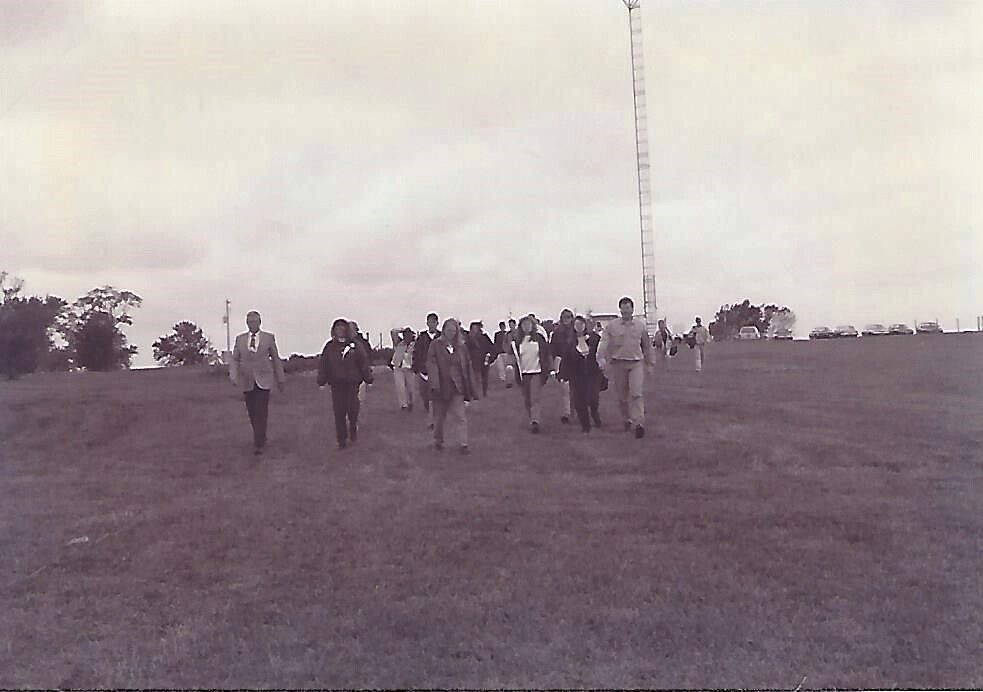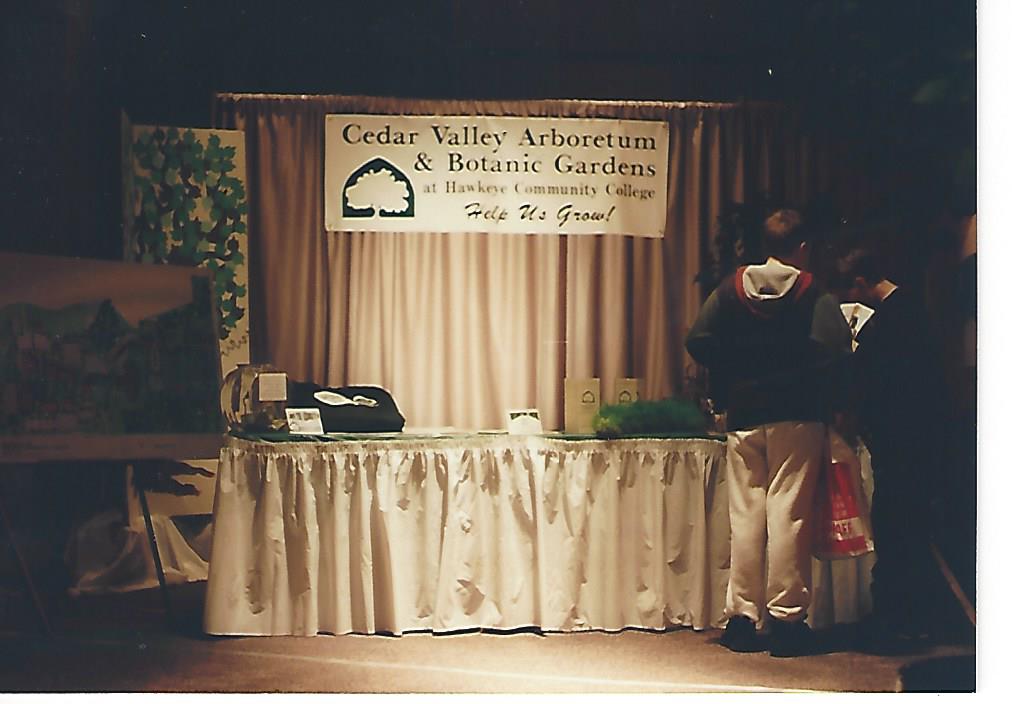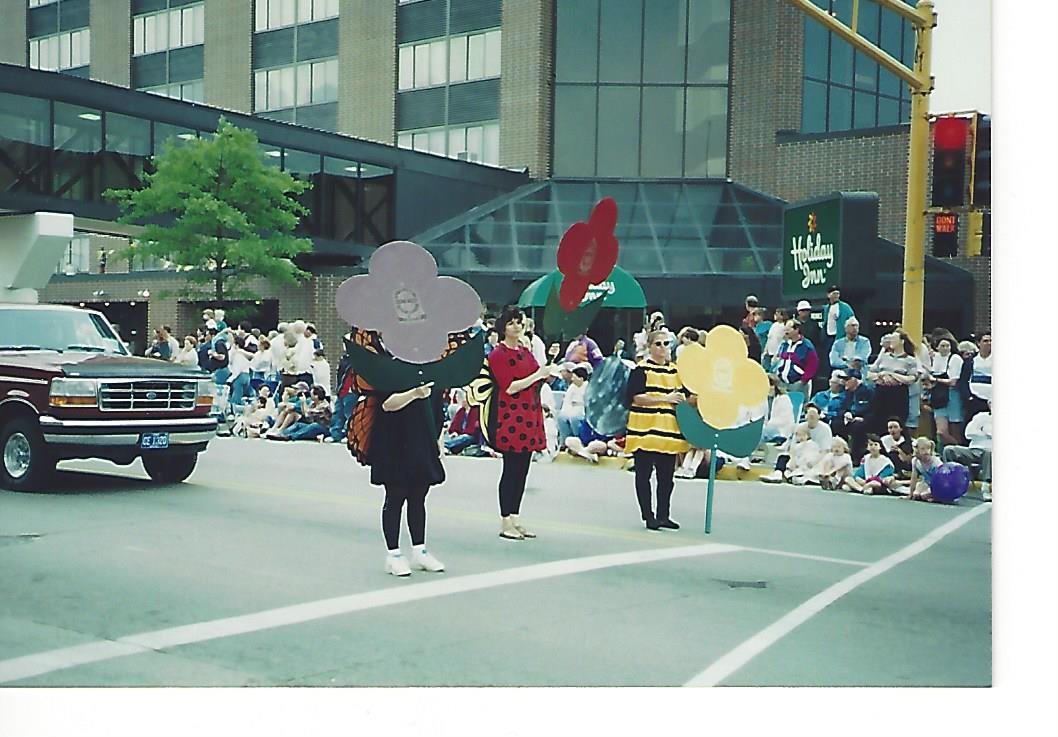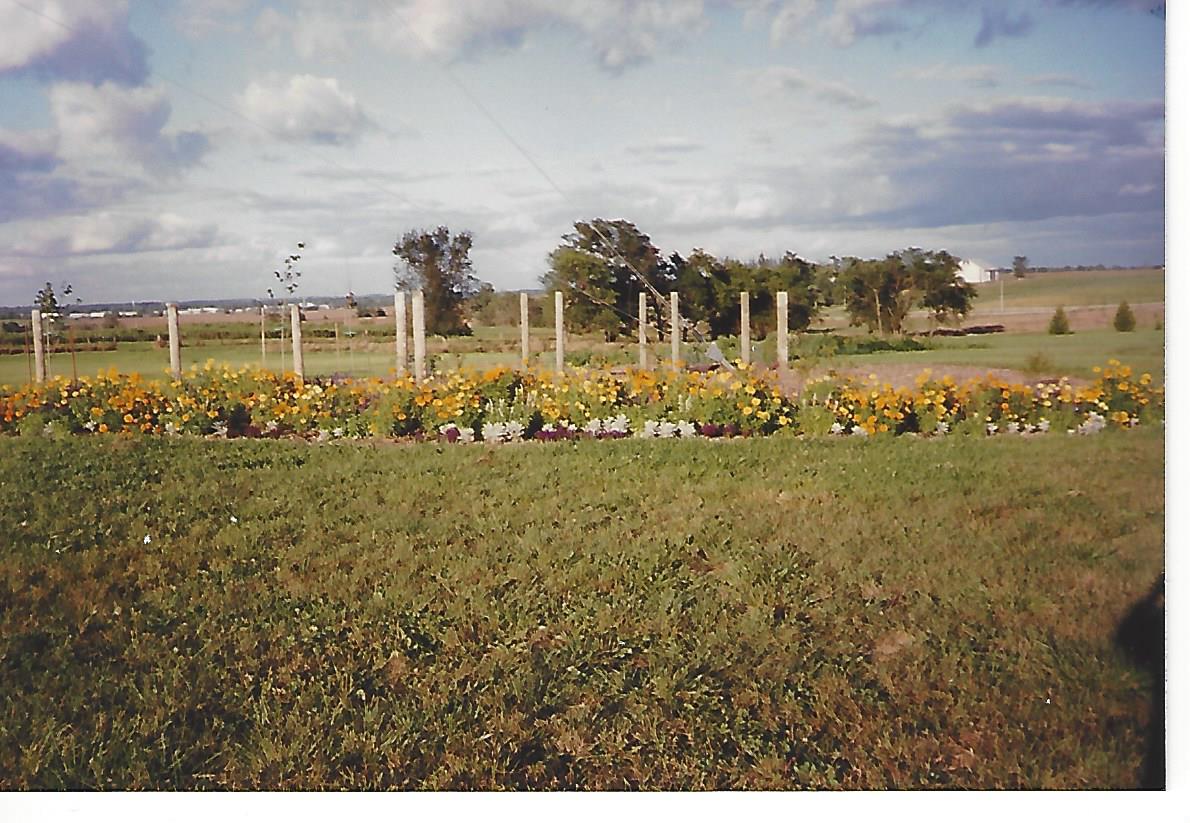The History of The Cedar Valley Arboretum - 1996
In January of 1996 a grant was obtained from the Hotel/Motel tax fund for $12,500. This money and other fund-raising efforts resulted in a total of $50,000 that was used to develop the Master Plan for the site of the Cedar Valley Arboretum and Botanic Gardens. An Ad Hoc Design Committee was formed and met in March, April, May, and June. Their task was to guide the development of the master plan. They visited the site on numerous occasions and met with Jerry Bolton and Rod Swinton from Hawkeye to discuss the transition from agricultural land use to vegetation cover suitable for the Arboretum as it began to assume management of the property.
The top photo of the design committee is captioned-planning and below is the design team on a visit to the site.
A national search was made to select a landscape architect to develop a master plan for the 74-acre site. Approximately 20 potential firms were contacted. Five were then selected for further review; three of which visited the site to be interviewed. Buettner and Associates from Fox Point Wisconsin teamed with Craig Ritland, a landscape architect from Waterloo was the group selected.
Craig Ritland met with a group consisting of Bob Lentz, Monica Smith, Robinson Engineering and other consulting engineers to discuss the impending connection of Hess Road with a new road going west to ensure that the layout and design of that road was compatible with the Arboretum master plan. This new road would become Arboretum Drive. The design team was given copies of the 1995 Prospectus and Financial Model that were prepared by the Arboretum committee. This team also received a conceptual sketch showing a “wish list” of theme gardens the committee would like to see included in the master plan. Four additional town hall meetings are held this year with various community groups and valuable input is gathered.
Even though we don’t have the Master Plan yet the design team knows that a big part of the site must actually become an Arboretum. The pasture land already has some small groups of trees dotted here and there about the site. There are several small groves of Honey Locust toward the East. There is a line of Cotton Woods along Hess Road, and there is a line of trees along the small stream that flows along the Western boundary.
In order to get things started, we will begin to surround the periphery of the site with various trees that are indigenous to Iowa. This year of 1996 just happens to be the Iowa anniversary of 150 years since we became a state. To honor that, our first tree planting in April was The Sesquicentennial Forest.
The following is from an article written by Craig Gibleon:
April 1996, The First Planting
“Local nurseries had dropped off 150 or so trees that were to be planted by the group Kelly Conrad and I were waiting for. HCC students enrolled in various programs on campus were going to plant more trees the following week in celebration of Earth Week. The rain subsided, and members of the CVABG’s first Board of Directors began arriving with shovels, coffee and lots of ambitious plans.
The only ray of sunshine we saw that morning was Jan Guthrie coming around to the various planting sites with words of encouragement for the volunteers. By midmorning, in spite of Jan’s best efforts, words of encouragement were being dampened by blowing wet snow. Every so often that snow would change to these weird little ice chunks the likes of which I had not seen in all my 45+ years in Iowa. I had been on site for four hours when Roger Jordan came up with his hair and eyebrows caked in ice chunks. He looked like some kind of Iowa Polar Bear headed for the cornfield. We planted trees until noon. With Jan’s offer of a warm lunch, shovels started dropping and there was a sudden retreat from the snow and ice. With our determination to plant in spite of the snow, ice, and wind, we began the Sesquicentennial Forest that day – a day none of the planters can ever forget.”
A good many trees were planted in the Sesquicentennial Forest. However, true to the idea of surrounding the site with the Arboretum, some trees were planted in other areas. I know that this year the White Spruce were all planted in a row starting at the Western end of the site toward the North. Pretty sure the River Birch were planted over toward the Southwestern end of the site. I also know that the row of lilacs along the South line from the West to the entrance were planted this year as well.
While we are talking about trees, I found the following photos of what looks like some sort of formal tree planting. Sadly, I don’t know anything else about it, but have a look anyway.
While the design team is busy developing the Master Plan, other volunteers are using events to introduce us to the community and if the events are at the Arboretum, Hawkeye allows us to use their buildings for any inside activities.
The Home Show Booth
The Easter Egg Hunt
Kathy Payne and Charlie Lott
The actual egg hunt is moved to the Arboretum grounds
Summer is parade season and we made sure to be well represented.
My Waterloo Days Parade
First place float in the Hazelton Flea Market Parade
The Independence 4th of July Parade
Cattle Congress
A main part of our mission at the Arboretum has always been education. In keeping with that and to become an asset to the community; education classes become part of what we do.
Putting Your Garden to Bed.
Pruning Class by Craig Gibleon
Natural Crafts Class by Phyllis Boeke
This first year of existence is a time to do whatever we can while we await the draft copies of our new Master Plan.
There is always the need for fundraising and one project was
Sesquicentennial Calendar: This raised $23,000. A total of 320 calendars and 49 prints were sold. The calendar was composed of 13 original prints by artist Jolene Rosauer.
Early Infrastructure: One necessity is water. The nearest source was a hydrant at the college. A hose is hooked to that and snakes its way up the fence-line to the Arboretum.
Porta-potty: If people are going to be on site for any length of time working, you probably need some basics.
Fence removal: The site has been a livestock pasture and is fenced in. One early project is to begin to remove it. This would be an ongoing project over several years.
Hess Road Connection: The Arboretum site boundaries are the roads that surround it. Orange Road to the South, Campus View Drive to the West, the not yet constructed Arboretum Drive to the North, and on the East, what is still a dirt road in 1996, Hess Road. In this first year of projects, there is no easy access to the far Eastern part of the site over by Hess Road. There is a small creek cutting that part off from the rest. This project is to install a culvert in the creek bed to allow for the construction of a “bridge” over the creek.
Hess Road
With access to this part of the site; we began to clear out some brush
With the luxury of hindsight I can tell you that:
There are 22 gardens shown on the Master Plan garden index and are introduced in the first two phases. Here they are, we will talk about them as we travel along the timeline in this series of articles.
Phase one-A
Arrival/Annual Garden; Demonstration Gardens; Community Gardens, Vegetable and Sensory Garden; Wedding Garden; Walled Garden; Herb Garden; Children’s Garden; Shrub Rose Garden; Formal Rose Garden
Phase one-B
Perennial Garden; Water Garden; Butterfly Garden; Bird Garden; Shrub Garden; Pergola Garden; Ornamental Grass Garden; Fern Grotto; Moon Viewing Garden; Shade Garden
Phase two
Contemporary Japanese Garden, Native American Garden
In 1996, as you have seen, there is limited access to water, there is no real parking lot, and nothing here but trees. However, a few intrepid volunteers decided to get started with at least one garden.
Access to the site was via an old stock fence gate and a small parking area exists close to the tower. Just to the East of that parking space is a flat spot with a few fence posts. This would become the very first actual garden at the Arboretum. It started out being called:
· Wattle Garden
The space where the first ornamentals were planted would become known as the Wattle Garden (a Wattle is a fence made out of sticks). It was the very first garden and in addition to clematis growing up the posts it also had a display of annuals around the outside.
Andrea Williams and Darla Thompson
Annuals in the Wattle Garden
But more folks were eager to get started.
Here is an article written by Craig Gibleon.
Summer 1996
“The idea of a Community Garden is a popular one. Our area is blessed with an abundance of individuals with the expertise to turn a 100-square-foot garden plot into a showpiece. A Community Garden would bring a number of these people together and help solidify the Arboretum’s volunteer base.
Our friends at HCC helped us again. The Grounds Department brought in equipment, and graded the site for drainage and leveling. Before they went back to work on campus, they put down grass seed, leaving the rest to CVABG volunteers.”
Over the next few weeks, a limestone walkway was installed and future planting beds were marked and rototilled. By fall, the soil in the planting beds had been fortified and fertilized. Plans for an early spring planting were well underway as “rules” for planting had been written and mailers were at the printer.”
I recall from my first-year volunteering that you had to submit a plan and have it approved in order to have your own community garden, this was in 2009, these would be the rules referred to here, I guess.
To round out this look at our beginnings:
FIRST BOARD OF DIRECTORS
Charlie Lott Craig Gibleon Kelly Conrad Wanda Sauerbrei
Leila George Maurine Crisp Rosemary Beach Jolene Rosauer
Joy Swartz Jan Guthrie




















































